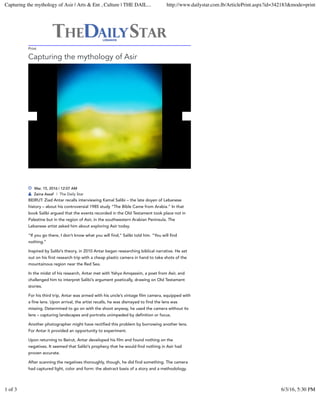
Capturing the mythology of Asir | Arts & Ent , Culture | THE DAILY STAR
- 1. ! | The Daily Star Print Mar. 15, 2016 | 12:07 AM Capturing the mythology of Asir " Zeina Assaf BEIRUT: Ziad Antar recalls interviewing Kamal Salibi – the late doyen of Lebanese history – about his controversial 1985 study “The Bible Came from Arabia.” In that book Salibi argued that the events recorded in the Old Testament took place not in Palestine but in the region of Asir, in the southwestern Arabian Peninsula. The Lebanese artist asked him about exploring Asir today. “If you go there, I don’t know what you will find,” Salibi told him. “You will find nothing.” Inspired by Salibi’s theory, in 2010 Antar began researching biblical narrative. He set out on his first research trip with a cheap plastic camera in hand to take shots of the mountainous region near the Red Sea. In the midst of his research, Antar met with Yahya Amqassim, a poet from Asir, and challenged him to interpret Salibi’s argument poetically, drawing on Old Testament stories. For his third trip, Antar was armed with his uncle’s vintage film camera, equipped with a fine lens. Upon arrival, the artist recalls, he was dismayed to find the lens was missing. Determined to go on with the shoot anyway, he used the camera without its lens – capturing landscapes and portraits unimpeded by definition or focus. Another photographer might have rectified this problem by borrowing another lens. For Antar it provided an opportunity to experiment. Upon returning to Beirut, Antar developed his film and found nothing on the negatives. It seemed that Salibi’s prophecy that he would find nothing in Asir had proven accurate. After scanning the negatives thoroughly, though, he did find something. The camera had captured light, color and form: the abstract basis of a story and a methodology. Capturing the mythology of Asir | Arts & Ent , Culture | THE DAIL... http://www.dailystar.com.lb/ArticlePrint.aspx?id=342183&mode=print 1 of 3 6/3/16, 5:30 PM
- 2. The fruit of that labor is nowadays on show in Antar’s “After Images: Stories from the Mountains of Asir,” curated by Hans Ulrich Obrist and Manal Khader, with poems by Yahya Amqassim, now up at Beirut Exhibition Center. “I wanted to ... [differentiate] documentation and research, and how to represent it,” Antar says in an interview with Hans Ulrich Obrist, published in the handsome volume accompanying this show. “It became a project on history and geography in relation to mythology – history and geography being the research and documentation, and mythology the representation.” The research and the mythology are clearly separated into two galleries. In the well-lit exterior space, visitors encounter the research, with 28 photos hung on its central wall, flanked by Amqassim’s commissioned poems and their translations. Beneath each photo and poem, takeaway copies are stacked on knee-high tables that circle the room. Antar describes this as a social act, encouraging visitors to take whatever poems and images they like to create a personalized version of his research. These intimate (in-focus) photos of mountainous landscapes – with their lone trees, curving roads and distant villages – radiate nostalgia, in the colors, light and occasional particle debris on the lens. Not all the 28 photos are simple documents of Asir landscapes. Some play with composition and movement, while others capture desolate highways and cloudy skies that could be from any place. The interior gallery houses the mythology section and Antar’s lensless experimental works. Here the white cube gives way to black walls, spotlights and installations. The impact of these large-format abstract photos is intensified by their color saturation and it becomes apparent that, in most cases, they’re grouped by subject matter. A cluster of portraits, rural and urban landscapes, some from European and Lebanese locations, can be guessed at. Many of the photos were taken in Asir, though, and in their abstract form the viewer can imagine the shape and hue of mountains and the colorful village clothing that Antar describes in the publication text. The artist suggests that if the light and forms of a geographical location is so abstract then why not shoot in other places that could represent that mythology? This part of the show embraces photos of well-known monuments in Paris, London and the Lebanese town of Sidon, Antar’s hometown. Iconic as they are to these locations, these landscape images seem slightly incongruous with the premises of the show. Their connection to the mythology of the Asir mountains is certainly marginal. Their incongruity does find meaning, however, if viewers are willing to embrace Antar’s impish critique of the popular reception of one religious source text (the Bible) and acknowledge that such criticism is equally applicable to any foundational narrative. “After Images,” and its beautifully designed publication, illustrate and aestheticize Salibi’s argument while opening up a rural region of the Arabian Peninsula to its historical ties to the rest of this region, and its several mythologies. Using figurative and abstract photography and poetry to explore myth and history, in its various interpretations, Antar challenges onlookers to reconsider what sort of truth is more important to them. Capturing the mythology of Asir | Arts & Ent , Culture | THE DAIL... http://www.dailystar.com.lb/ArticlePrint.aspx?id=342183&mode=print 2 of 3 6/3/16, 5:30 PM
- 3. As Amqassim writes in his poem, “After Seeking Eve: Adam Repairs Back to Exile,” “Light growing and sprouting from your mouth / You emerge bewildered and perplexed” “After Images: Stories from the Mountains of Asir,” curated by Hans Ulrich Obrist and Manal Khader, with poems by Yahya Amqassim, is up at Beirut Exhibition Center through March 22. Copyrights 2016, The Daily Star - All Rights Reserved 15/03/2016 Capturing the mythology of Asir | Arts & Ent , Culture | THE DAIL... http://www.dailystar.com.lb/ArticlePrint.aspx?id=342183&mode=print 3 of 3 6/3/16, 5:30 PM